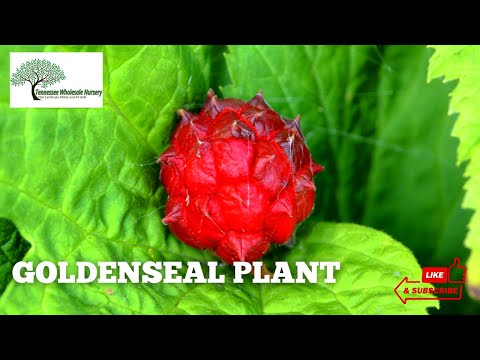Goldenseal Plant For Sale
The Goldenseal Plant (Hydrastis Canadensis) is a delightful herb native to the eastern USA. Its sturdy, straight stalks and umbrella-like leaves make it a charming addition to your deciduous forest understory. The leaves of Goldenseal Hydrastis are highly textured, and the fine hairs covering the entirety of the leaves glisten when struck by the sun, creating an enchanted forest feeling.
The perennial plant produces one petal-less flower composed of only white stamens. Once pollinated, a bright red raspberry-like fruit develops, creating a vibrant contrast with its vivid green leaves. Since the berries develop atop very short stems, it looks as though they are being offered for eating on a leafy green platter.

Goldenseal Plant Details
Family: Ranunculaceae
Hardiness Zones: 3 to 8
Light Requirement: Partial sun to full shade
Water Needs: Moderate
Height: 10 to 15 in
Spread: 10 in to 2 ft
Growth Rate: Slow
Bloom Time: April to May
Flower Color: Greenish-white.
Wildlife Value: Red berries can be consumed by wildlife
The Goldenseal plant develops from its yellow-colored rhizomatous roots, which is where the plant gets its common name. It blooms in mid- to late spring and creates an inviting ground cover in moist areas of the garden. Once the plant has reached reproductive age, it produces two leaves per plant, arranged alternately; however, immature leaves are still produced on a single stalk.
It is a popular medicinal plant used to cure flu and cold symptoms. It is one of the earliest recorded American medicinal plants and is regularly a top seller in the medicinal market.
Landscape Uses and Maintenance
It thrives in shady areas of the garden and enjoys moist, well-drained soil. While it does prefer moist soil, it is tolerant of many different soil types and pHs.
Goldenseal Plant requires no maintenance once established. Add this native to your medicinal garden and enjoy it for its delightful visual appeal and wellness properties alike. Or plant it among taller, shade-producing overstory in your garden to produce a luscious understory counterpart.
Noteworthy Characteristics
Medicinal, delightful ground cover, low-maintenance. This charming ground cover is an excellent addition to your native garden or wetland landscape. Shop for Goldenseal Plants online at TN Nursery. For 68 years, we have served the landscaping industry and homeowners with specimen plants.

Exposure
The Goldenseal plant thrives in partial to full shade. It prefers filtered sunlight or dappled shade, mimicking the forest floor conditions of its native habitat. Avoid total sun, as it can cause leaf scorch and inhibit growth.
Height at Maturity
Under 12"
Usage
Shade Plant
Shipped As
Bare-root
Ships
USPS
Planting Zones
4-8





